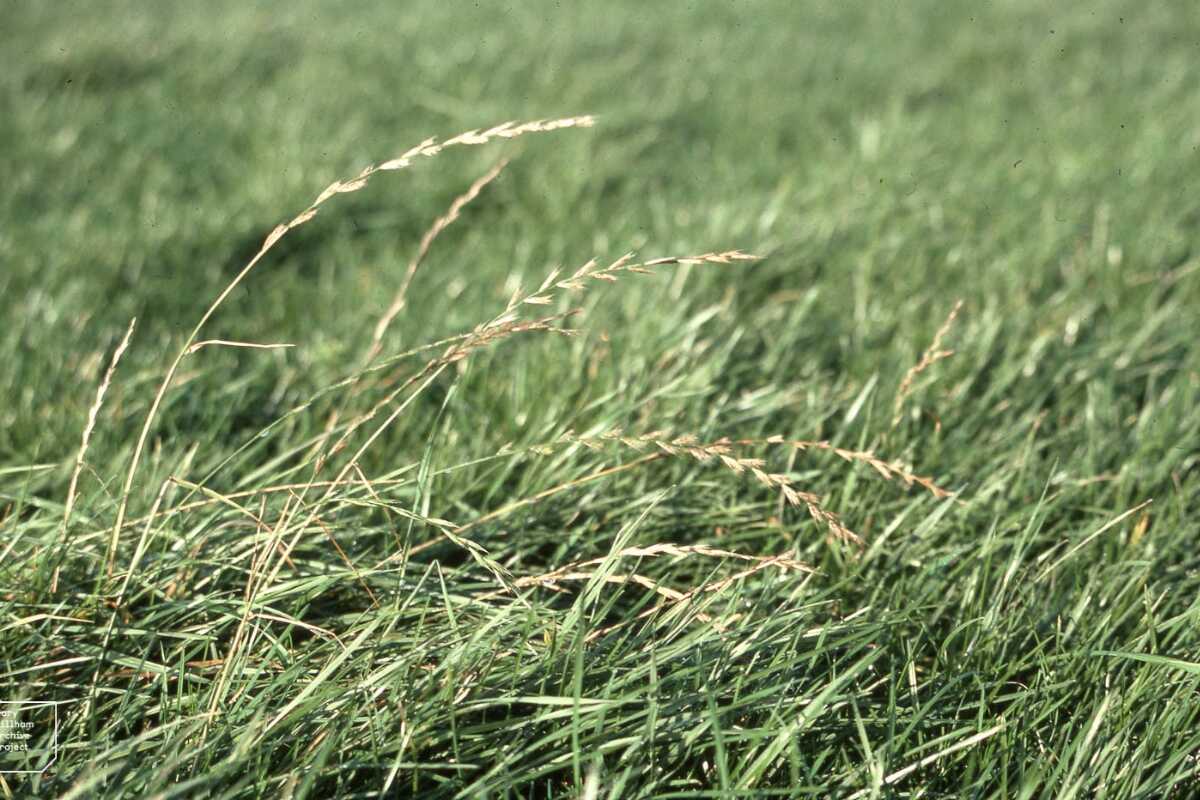
Need grass in a jiffy but don’t want to spend the money and break your back laying sod? Look no further than the quick-germinating perennial ryegrass. With the useful information in this guide to growing perennial ryegrass, you can go from seed to mowable lawn in about 21 days!
Perennial Ryegrass At A Glance
- Classification: Cool-season grass
- Spreads by: Bunch-type grass
- Soil type: Highly fertile, well-draining
- Soil pH: 6-7
- Mowing height: 1-3 inches
- Shade tolerance: Low
- Drought resistance: Low (may go dormant in the summer)
- Foot traffic tolerance: High, but doesn’t recover well
- Maintenance needs: Varies depending on cutting height
- Potential for disease: High
- Insect pest tolerance: Low to moderate
Other notes: Most often mixed with Kentucky bluegrass and fine fescue. Excellent striping ability. Germinates rapidly, so often used as a temporary lawn. Needs moderate levels of fertilizer.
The Basics Of Perennial Ryegrass
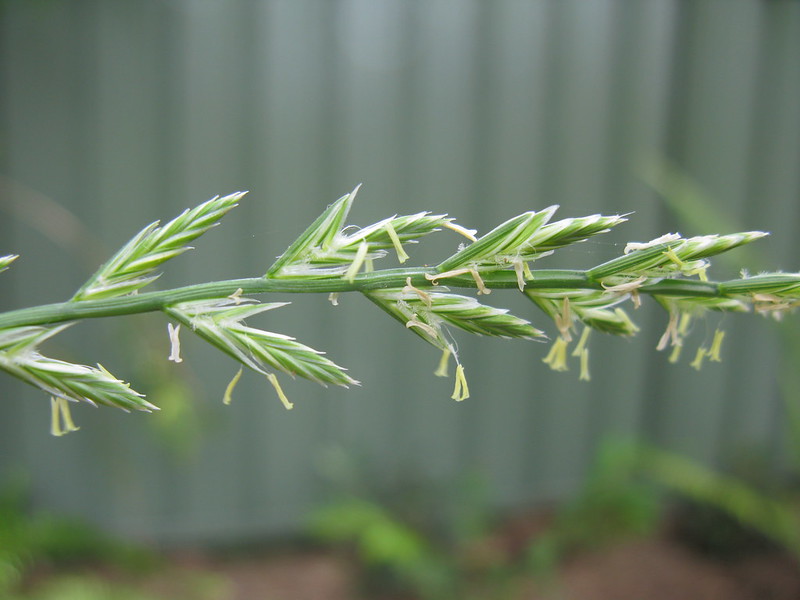
There’s no denying that perennial ryegrass (Lolium perenne) differs from Kentucky bluegrass, Bermudagrass, or Zoysia. This cool-season turf may take on a lighter green leaf blade color, and it develops clumps across your lawn instead of creating a thick, dense carpet.
However, if you need to grow grass quickly or a lawn with remarkable durability, you can’t go wrong with this choice. Perennial rye germinates in as little as five days and has excellent foot traffic tolerance, making it popular in athletic fields, golf courses, school yards, or lawns that take the wear and tear of children and pets. It loves full sun, but perennial ryegrass will grow in partial shade.
With moderate maintenance needs, you won’t be spending all your free time tending to your grass.
The soft-to-the-touch blades feel wonderful on bare feet as you stroll across the grass, but be forewarned. While it handles the foot traffic well, if it does thin or gets damaged, it can’t repair itself because of its growth habit, so you’ll need to overseed. Plus, it’s much more temperamental of the cold than other cool-season lawn grasses and doesn’t like temperatures below 30°F for long periods.
That said, there are three different ways to grow perennial ryegrass, which sets it apart from many other types of grass.
- It’s a good choice for a permanent lawn in cooler northern climates. It will go dormant during the winter in the transition zone and the less extreme areas of the north and then green back up in the spring. Note: The severe winters in the uppermost northern states and Canada can kill perennial ryegrass.
- Perennial ryegrass is grown by homeowners in southern climates as winter grass to provide color in areas where warm-season grasses go dormant. After winter months, when the summer heat returns, perennial ryegrass will go dormant, making way for warm-season turf.
- It’s also grown as a temporary grass because of its quick germination. Landscaping companies often plant it with Kentucky bluegrass to cover the soil until the KBG germinates and takes off. Then, down the road, they may get rid of it.
Perennial Ryegrass Cultivars
As scientists continue to work on breeding, more improved cultivars are coming on the market. These new grasses have better disease tolerance, are more tolerant of colder temperatures, and even turn a deeper dark green. A few new types have small stolons (above-ground stems) that help the grass regenerate and spread when it thins.
Research which cultivar works best for your life and needs so your grass withstands anything you put it through.
Some commonly available perennial ryegrass seeds include these cultivars:
- Amazing A+
- Haven
- Karma
- Nexus GT
- Nexus XD
- Nexus XR
- Overdrive 5G
- Shield
- Signet
- Stamina
Pros And Cons Of A Perennial Ryegrass Lawn
Perennial ryegrass is a great choice for homeowners who want something practical and low-maintenance but not so much for those obsessed with looks. Learn the pros and cons of this grass type to decide if it’s right for you.
Pros
✓ Not prone to build thatch
✓ Great for reel mowers
✓ Germinates fast
✓ Excellent striping ability
✓ Medium to dark green color
✓ Soft to walk on barefoot
✓ Excellent foot traffic tolerance
Cons
✗ Low shade tolerance
✗ Poor damage recovery due to lack of rhizomes
✗ Low heat and drought tolerance
✗ Often looks patchy
✗ Susceptible to fungal diseases, especially in hot, humid climates
Cool-Season Grasses Explained
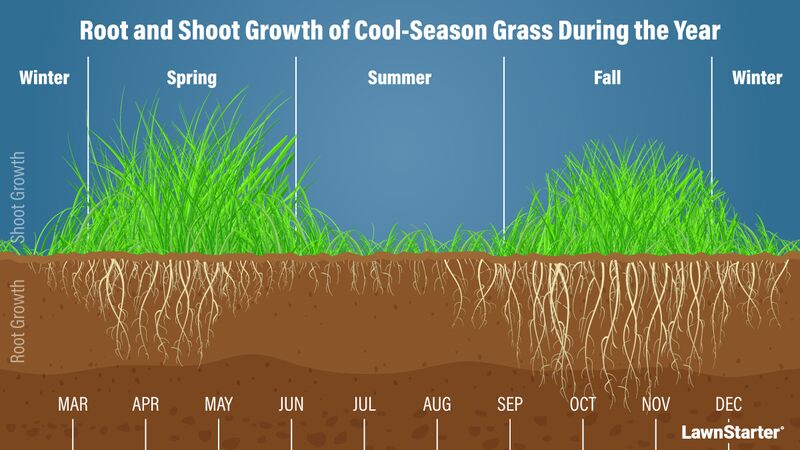
You’re probably familiar with the terms cool-season and warm-season grasses. But do you understand the difference? At the basic level, turf grasses are classified as one or the other depending on the climate they grow well in and how they grow in that environment.
The most popular cool-season grasses are perennial ryegrass, Kentucky bluegrass, fine fescues, and tall fescue.
Cool-season grasses grow across the northern US and parts of the transition zone. Compared to warm-season types, they can withstand colder winter temperatures but aren’t as equipped to handle the heat.
They start growing when spring temps climb above freezing (40 to 42°F) and grow like crazy when air temperatures are 65 to 75°F. Once the heat of summer rolls around, they may go dormant (instead of dying off) until temperatures cool a bit. Growth picks up and goes wild again in fall when temps are between 65 to 75°F. And then, when October or November rolls around, they go dormant to survive through the winter.
Understanding how it grows and goes dormant is important to better care for your perennial ryegrass.
How Do You Establish Perennial Ryegrass?
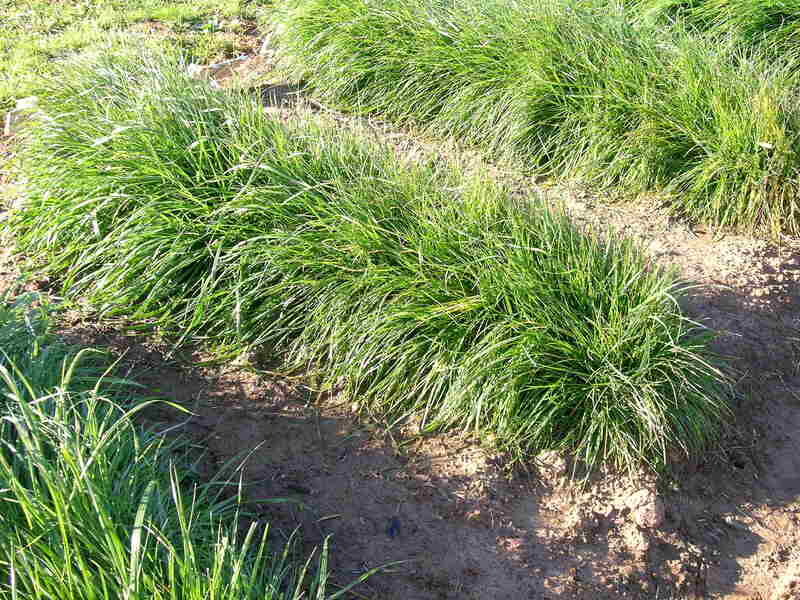
Perennial ryegrass is an anomaly compared to many other turf species. It is one of the few almost exclusively seeded and rarely started by laying sod. In many places, sod isn’t even available. So, why is this the case?
Seeds germinate extremely quickly, sometimes within as little as five days. This is unbelievable if you think about how Kentucky bluegrass can take up to 30 days! Since it sprouts so quickly, weeds aren’t a big problem, and the grass establishes rapidly. Hence, there is little need to put down sod.
The Cost of Starting Perennial Ryegrass
Perennial ryegrass seed: Pricing varies by brand and supplier; a 5-pound bag ranges from $20 to $44. Seed at 3 to 5 pounds of seed per 1,000 square feet.
- Grass Seed Options:
– Outsidepride Perennial Ryegrass Seed (5 lbs.)
– Eretz ProTurf Perennial Ryegrass Fine Lawn Seed (choose your size)
Perennial ryegrass sod: Costs between $0.40 and $0.85 per square foot.
When To Start Perennial Ryegrass Seed
Realistically, you can seed a lawn whenever you want. But when it’s a scorching 85°F out, your lawn will struggle to get going.
You want to time sowing seed with when your perennial ryegrass grows the most. Since it’s a cool-season grass (as mentioned above), perennial ryegrass grows the most in the cooler temps of spring and fall.
With this in mind, the best time to plant a new lawn is early fall, followed by late spring. Your grass does better if it starts to establish and then goes into winter dormancy versus if it germinates and then gets pounded by the summer heat.
In Northern areas, sow seed in mid-August to mid-September. If your home is in the transition zone, sow seed from mid-September through early or mid-October.
Choosing Between 100% Perennial Ryegrass and a Mixed Grass Lawn
Perennial ryegrass has many advantages as a lawn. Still, truthfully, it’s not grown on its own as a monostand as often as the other cool-season grasses. Usually, seed blends with other cool-season turfgrass species are cultivated to create a mixed grass lawn. And in many cases, ryegrass isn’t the primary grass, even in these cool-season seed mixes.
Growing a grass blend containing perennial ryegrass gives you a better combination of genetics, so your grass can withstand various conditions. A mixture with perennial ryegrass will have better foot traffic tolerance than Kentucky bluegrass offers, but Kentucky bluegrass handles the cold temperatures better.
However! That doesn’t mean you can’t grow a 100% perennial ryegrass lawn. There are some caveats, though. It would be best to live in an area without extreme winter and summer temperatures (think Oregon, Washington, or the Carolinas). Plus, expect to spend a fair amount of time reseeding bare patches if you want even coverage.
If you’re going to establish a lawn solely with perennial ryegrass, you must consider a few things before buying a bag of seed:
- Buy only improved turf-type perennial ryegrass varieties. You do not want a seed that is a common or forage-type species. These will not produce a high-quality lawn.
- Talk to a local cooperative extension specialist. See if a monostand is a good idea in your climate. It is susceptible to winterkill if temps are too low and suffers from high summer disease pressure if it’s hot and humid.
How to Care For An Established Perennial Ryegrass Lawn
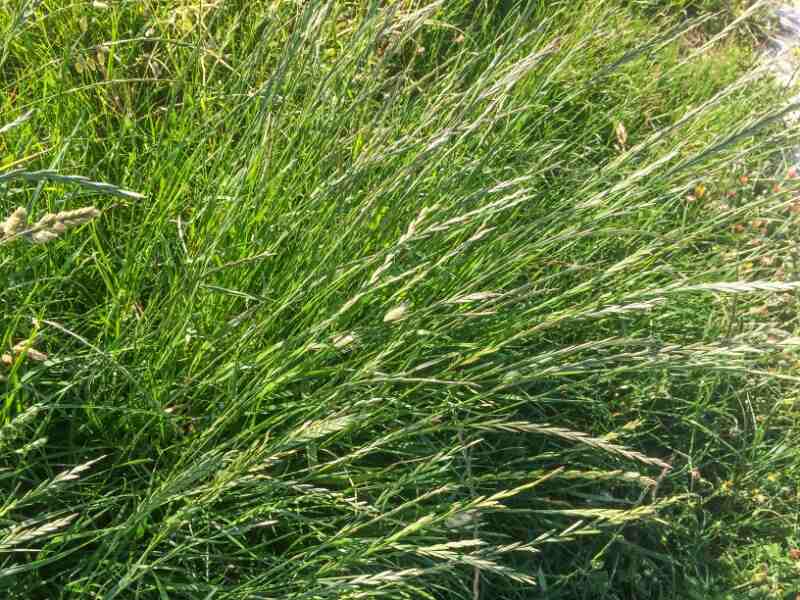
Perennial ryegrass is tough and doesn’t need too much maintenance compared to other types of turfgrass, but it still takes some maintenance to keep it looking its best.
Keep Your Perennial Ryegrass Well-Watered
The key to this type of grass is to give it enough water, especially in the summer, to keep it from going dormant. Perennial ryegrass has a short root system, and in turn, it isn’t very drought tolerant. It needs at least 1” of water (via rain or irrigation) weekly to keep it growing.
You might be wondering if it’s problematic if your lawn goes dormant in the summer. The answer is yes. If perennial ryegrass goes summer dormant, it will recover slowly and be more susceptible to insects, diseases, and weeds.
Fertilize to Keep It Looking Nice
Fertilize using 4 pounds of nitrogen (N) per 1,000 square feet yearly when actively growing (February to June; October to December). Run a soil test every few years for the most accurate fertilizer recommendations.
Like other cool-season lawns, apply most of the fertilizer to your grass in the late summer to early fall. You can also give your yard a small boost of nutrients in spring after it comes out of dormancy and starts to green.
Need help to choose a fertilizer? Check out our guide on How to Choose the Right Lawn Fertilizer.
Choose Your Mower Based On the Grass Height
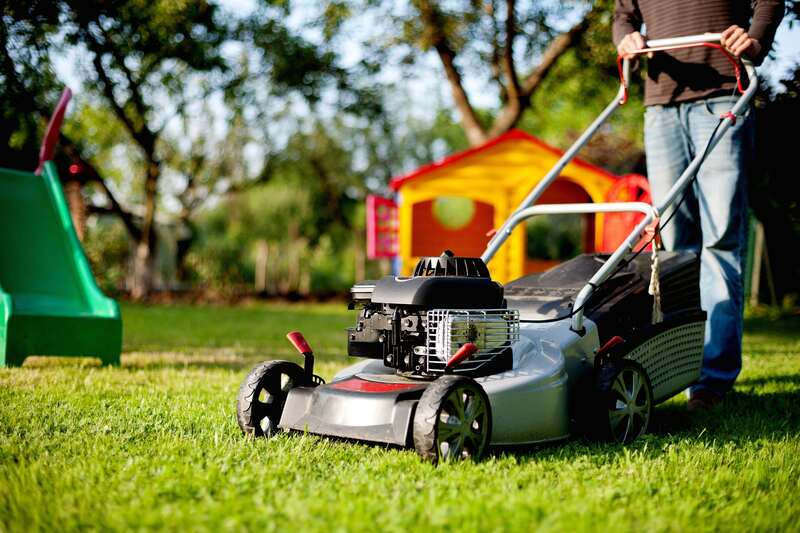
For 100% perennial ryegrass lawns, you’ll want to mow your lawn at 2 to 3 inches, which you can accomplish with a standard rotary mower. You can also use a reel mower—which I understand not everyone has—to keep the grass shorter than 1”.
Regardless of the type of mower you use, try to take off no more than one-third of the grass height each time you mow. If you’re keeping your grass shorter, you’ll need to trim often to follow this rule. Also, keep your mower blades sharp to cut off the spikelets of seed heads that develop cleanly.
Note: Check out our article containing the best mowing tips if you need to brush up on your grass-cutting skills.
Keep Air and Water Moving into the Soil
Thatch isn’t usually a problem with perennial ryegrass since it’s a bunch-type species. It doesn’t produce thatch like Kentucky bluegrass or fine fescue, so dethatching is rarely necessary.
However, you must still watch for soil compaction and aerate the lawn as needed.
Over time, the soil under your lawn may naturally compact from the weight of the mower or foot traffic across it. The soil particles are pushed together as it gets compressed, and the free space between them gets squeezed out. Water, oxygen, and fertilizer nutrients hang out in this free space. So, when the soil becomes compacted, these things sit on top of the soil surface instead of moving down into the root zone.
Core aeration is the most efficient way to break up soil compaction. Heavy clay soils can be aerated every spring or fall, and lighter soils can stretch to every two or three years. During the process, soil plugs are pulled from the ground, opening up the compaction, allowing water and air to permeate the soil.
Weed Control Options
Ryegrass has an interesting characteristic. It is an “allelopathic” grass: as it grows, it releases a chemical that inhibits other plants’ growth. They absorb this chemical when they take water through their roots, resulting in stunted growth.
This trait is beneficial for helping to slow weed growth in your lawn, but it’s important to know it won’t completely get rid of all of the weeds. Keep this trait in mind when planting near something you don’t want negatively affected.
To prevent weeds from sprouting up in your lawn, I highly recommend using a pre-emergent herbicide in the early spring or fall to prevent summer and winter annual weeds. Then spot-treat with a post-emergent product such as 2,4-D, dicamba, or mecoprop as needed.
Pro Tip: Pre-emergent products must be put down when soil temperatures are below a certain threshold. Check with your local extension office for the best time to apply.
Prevent Insect and Disease Problems
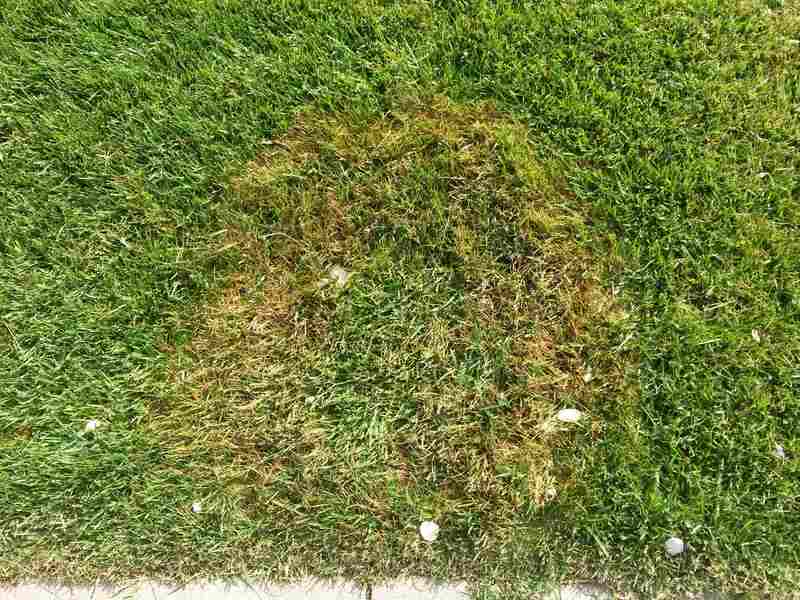
Insects and diseases can be problematic in perennial rye, but they don’t have to be a life sentence. Regularly scout your lawn and treat problems quickly when you notice anything wrong.
Early treatment can help keep issues from becoming big problems. Following are some insect pests and lawn diseases to look out for in particular with perennial ryegrass.
Common insects that bother perennial ryegrass include:
Remember how this grass exudes chemicals that inhibit growth around it? Well, you can also choose endophyte-enhanced varieties. The endophytes produce alkaloids that deter insects from coming in and munching on the grass.
Perennial ryegrass is also susceptible to the following fungal diseases:
- Necrotic ring spot
- Summer patch
- Gray leaf spot
- Dollar spot
- Brown patch
- Red thread
- Rust
- Pythium blight
Prevention is the best way to keep problems to a minimum regarding diseases in your perennial ryegrass. Don’t overapply nitrogen, avoid overwatering, and aerate regularly so water moves through the soil instead of sitting on the surface.
Another great way to halt disease problems is to plant your lawn in a mix of perennial ryegrass and turf-type tall fescue. Tall fescue has excellent disease resistance.
FAQ About Perennial Ryegrass
Once temperatures reach about 87°F, perennial ryegrass goes dormant and stops growing. The grass doesn’t die, though. Once the temperatures drop again, it will come out of dormancy and grow again.
Perennial rye will come back year after year when cared for, as long as temperatures aren’t too extreme. Annual ryegrass only grows for a single season, maybe two (and grows as a biennial) if the winter is mild enough to keep growing.
Yes, you will need to reseed your perennial ryegrass when you see bare patches or thin spots. It’s best to seed in the early fall, at least 60 days before the first expected fall frost.
Get Help With Your Lawn Care
Perennial ryegrass is a great turf choice if you need a lawn that’s highly resistant to foot traffic, whether for kids or pets. If you think this grass is a good fit for you, contact a local lawn care professional through LawnStarter today. They can help you choose, install, and care for your grass, giving you the best lawn possible with minimal effort on your part.
Main Photo Credit: Dr Mary Gillham Archive Project / Flickr / CC BY 2.0
LawnStarter participates in the Amazon Services LLC Associates Program, an affiliate advertising program. LawnStarter may earn revenue from products promoted in this article.